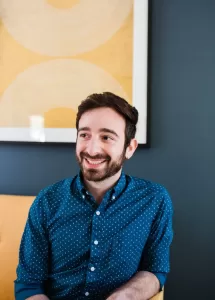Biofeedback for Brain Health
How EEG Biofeedback Therapy and Neurofeedback Improve Brain Function
Before becoming a full-time homeopath, I practiced both biofeedback and neurofeedback therapy for over five years. Through this work, I witnessed the potential of these modalities to help individuals with ADHD, anxiety, depression, and cognitive challenges.
Over time, however, I found that homeopathy offered even more comprehensive, lasting results — addressing the root patterns behind neurological imbalance in a truly individualized, non-invasive way. That’s why I now focus solely on homeopathy at The Healing Narrative.
What Is EEG Biofeedback Therapy?
EEG Biofeedback Therapy is a form of brain training that helps individuals monitor and improve their brainwave activity in real time. Using electroencephalogram (EEG) technology, this therapy reads brain signals through sensors placed on the scalp. These signals are then translated into visual or auditory feedback—essentially, your brain gets to “see” itself in action.
This process is entirely non-invasive and backed by over 40 years of research in neuroscience. The goal? To retrain the brain to operate more efficiently and regulate itself, promoting emotional balance, focus, and cognitive clarity.
How Neurofeedback Works to Improve Brain Function
Neurofeedback is a specialized form of biofeedback that zeroes in on brainwave activity. When your brain is functioning optimally, it produces different types of waves (alpha, beta, delta, theta) in appropriate patterns. However, chronic stress, trauma, or developmental conditions can disrupt this balance.
Neurofeedback helps restore harmony by:
- Measuring your real-time brainwave activity
- Providing feedback (visual/auditory cues) when your brain moves toward more regulated patterns
- Reinforcing positive brainwave behavior through repetition and reward
Over time, this leads to improved concentration, emotional regulation, sleep, and overall brain function.
From my years practicing neurofeedback, I found that while brain training can be a powerful tool, it often required consistent reinforcement and ongoing sessions. In contrast, homeopathy offers the potential for deeper healing that requires fewer interventions over time.
Conditions Treated with EEG Biofeedback
Research and clinical experience show that EEG biofeedback therapy is effective for a range of neurological and psychological conditions. These include:
- ADHD and ADD
- Anxiety and panic disorders
- Depression
- PTSD and trauma
- Migraines and chronic pain
- Sleep disturbances
- Cognitive decline and brain fog
It’s also used for peak performance training—helping athletes, artists, and high performers enter flow states more easily.
EEG Biofeedback Therapy for ADHD and Anxiety
Two of the most well-researched applications of neurofeedback are for ADHD and anxiety. For individuals with ADHD, the brain often struggles to regulate attention and impulse control. Neurofeedback strengthens the brain’s ability to maintain focus without relying on stimulants.
For anxiety, where the brain may be stuck in high-frequency beta waves (associated with worry and hypervigilance), neurofeedback encourages a shift toward calmer alpha waves, reducing symptoms naturally over time.
Many of my clients have reported life-changing improvements in these areas—gaining better focus, improved sleep, and reduced reliance on medication.
Comparing Biofeedback and Neurofeedback
While they’re related, there are key differences:
- Biofeedback involves monitoring physiological signals like heart rate, muscle tension, or skin temperature. It’s often used for stress reduction, pain management, and muscle training.
- Neurofeedback focuses exclusively on brainwave activity and is particularly effective for neurological and emotional regulation.
Both therapies aim to promote self-regulation and mind-body awareness, but neurofeedback is uniquely suited for addressing brain-based issues like ADHD, anxiety, and trauma.
What to Expect During a Neurofeedback Session
While I no longer offer neurofeedback therapy in my practice, I provided this work for years and understand its process intimately. Here’s what a typical session may involve when working with a neurofeedback provider.
- Initial Assessment: We begin with a comprehensive intake and sometimes a brain map (QEEG) to identify dysregulated patterns.
- Sensor Placement: Small sensors are placed on your scalp using conductive paste. These sensors only read—nothing is being sent into your brain.
- Training Session: You watch a movie or animation while the equipment provides real-time feedback. When your brain moves toward a desired state, the movie plays clearly. If not, the screen dims or sound drops out—your brain learns from this.
- Consistency: Most people begin with 10–20 sessions. Benefits are cumulative and long-lasting.
The experience is calming, often even meditative, and many clients feel better after just a few sessions.
Why I Chose to Focus on Homeopathy
After practicing EEG biofeedback and neurofeedback for over five years at integrative clinics in New Jersey, I came to a personal and clinical realization: homeopathy consistently brought about more profound and lasting changes in clients’ mental, emotional, and neurological health. Unlike neurofeedback, which relies on technology and repeated sessions, homeopathy works by stimulating the body’s own innate healing intelligence — often resolving deep-seated patterns from within.
- ADHD and attention difficulties
- Anxiety, overwhelm, and panic
- Depression and emotional flatness
- Mental fatigue and cognitive fog
Each client receives a carefully selected remedy tailored to their unique physical, mental, and emotional patterns, helping to restore calm, focus, and mental clarity over time — without the side effects of conventional drugs or the complexity of machine-based therapies.
Frank Molignano, CCH, RSHom(NA), is a board-certified homeopath with over 15 years of experience helping people heal from trauma, chronic illness, and mental health challenges. He formerly practiced biofeedback and neurofeedback therapy for over five years, and while he no longer offers these treatments, he now focuses on homeopathy, which he finds offers deeper, lasting results.
Frank works with clients virtually across the U.S., especially in New Jersey, New York, California, and Colorado. When not in session, you’ll find him bouldering, paddle-boarding, or dancing. Learn more about Frank here.

